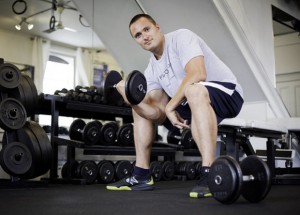The 5 most common weight training mistakes
The fitness industry is full of misinformation, but I’m going to try to give you some advice on the basic faux pas I’ve seen over the years.
Fitness is not an exact science; everyone reacts differently and has different preferences. Some people like certain trainers or certain schools of thought. The following is what I like and what works for me, but I’m certainly not an expert.
I’ve been doing this for over 10 years consistently. Here are the 5 most common mistakes I see.
1. Exercise selection
There are four staple exercises of weight training: Squat, bench press, deadlift, and overhead press. Every program should include these. If your exercises are all or mostly barbells, you’re further ahead than most.
These exercises require proper technique. To learn the technique on your own, I suggest you search YouTube for the Mark Rippetoe videos on each exercise. Watch them twice. Try to emulate what you see in the gym. Watch them again. Try to emulate them again. It takes practice. Keep at it.
These exercises are for anyone who can perform them safely. They will make you stronger, bigger, increase flexibility/mobility, and have a host of other health benefits. These are the meat and potatoes of weight training.
If your exercises consist of only assistant exercises like machines, cables or dumbbells, it’s like eating a dinner consisting of only sides. You wouldn’t have a bunch of sides every day for meals, would you? No you wouldn’t, so don’t do it in the gym.
2. Workout programming
Anything to do with fitness is based on the process of adaptation.
You invoke a stress on your body, and your body adapts to the stress. If you consistently evoke the same stress on the body, then the body does not need to adapt. Therefore, you need to keep challenging your body in order to make progress.
In weight training, you can do this by manipulating variables in your programming. These include amount of resistance (weight), repetitions of an exercise (reps), and repeating bouts of reps after a rest (sets). These are the basic variables we can manipulate to make sure we’re triggering our body to adapt.
Beginners can use the principle of progressive overload with overwhelming success. All you have to do is increase the amount of one variable each workout. So every workout, add weight or a rep or a set and you will improve.
As you become better, the margins for these obviously get smaller. As a beginner you may be able to add 5-10 lbs. to your squat every workout, but eventually you will only be able to add 1-5 lbs. I never see anyone using the 2.5 pound or less weights, but these weights will help you improve!
Remember that any increase causes new adaptation even if it is small; it is still progress.
3. Intensity
 To achieve these incremental increases in weight, reps, or sets, you’re going to have to dial up the intensity at a certain point.
To achieve these incremental increases in weight, reps, or sets, you’re going to have to dial up the intensity at a certain point.
It’s not easy to push your body to levels it’s never been before, but it’s definitely possible for everyone. Mostly I see students not going hard enough at the gym, but occasionally some go too hard.
Putting excessive stress on the mind/body through fitness can negatively impact your ability to focus in school. There is an optimal zone where intensity and the ability to recover are in an equilibrium that promotes overall health.
For example, you continually increase the weight, then find it very draining and hard to recover from. In this scenario, if you decrease volume (reps/sets either in a certain exercise or over the entire workout) you will correct this fatigue problem and continue making progress. Listen to your body and make the necessary adaptations.
4. Too much gym time
More is not always better. Like most things in life, quality is usually better than quantity.
I go around 2-3 days per week, which I feel is enough for anyone who does this recreationally. If you are going 5-6 times a week, you should take a step back and think about coming up with a more efficient plan.
During exams, I may go once or twice in a 2 week span and dial back the intensity. I never forget that I’m at university to learn and not work out. The gym will always be there after an assignment, midterm or final, so make sure schoolwork is your first priority.
You only get one shot at getting a good grade so make it count, whereas you can always go to the gym.
5. Fitness fads
In the media, the promotion of health and fitness could not be bigger than it is today. Unfortunately, health and fitness get misconstrued in an effort for companies to make money. There are billions of dollars at stake and everyone wants an easy fix.
There is no miracle pill that instantly makes you lose weight or get in shape. There are supplements that promise to turn you into a fitness model, but if they are effective, they usually contain substances banned by anti-doping agencies.
Having a healthy diet is not enough for overall health; you need physical activity. Taking 20,000 steps per day is not enough to improve your overall health. You need to get your heart rate up. You need to be sweating. You need to be uncomfortable. You need to push your limits.
Some general advice
There’s no need to waste money on chemical supplements or take performance enhancing drugs. During my training career I knew many people who took performance enhancing drugs/supplements, and now they look terrible. They all regret it. Don’t do it!
Fitness is a marathon, not a sprint. Don’t get discouraged. Everyone has the ability to get into shape after a long period of inactivity.
There is some sort of physical activity for everyone. Even if weight training is not for you, make sure you do any activity to your best ability/intensity.
Some great books to check out are: Starting Strength and Practical Programming for Strength Training both by Mark Rippetoe, and 5/3/1 by Jim Wendler.





